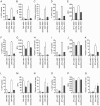Incorporating double copies of a chromatin insulator into lentiviral vectors results in less viral integrants
- PMID: 19239708
- PMCID: PMC2651870
- DOI: 10.1186/1472-6750-9-13
Incorporating double copies of a chromatin insulator into lentiviral vectors results in less viral integrants
Abstract
Background: Lentiviral vectors hold great promise as gene transfer vectors in gene therapeutic settings. However, problems related to the risk of insertional mutagenesis, transgene silencing and positional effects have stalled the use of such vectors in the clinic. Chromatin insulators are boundary elements that can prevent enhancer-promoter interactions, if placed between these elements, and protect transgene cassettes from silencing and positional effects. It has been suggested that insulators can improve the safety and performance of lentiviral vectors. Therefore insulators have been incorporated into lentiviral vectors in order to enhance their safety profile and improve transgene expression. Commonly such insulator vectors are produced at lower titers than control vectors thus limiting their potential use.
Results: In this study we cloned in tandem copies of the chicken beta-globin insulator (cHS4) on both sides of the transgene cassette in order to enhance the insulating effect. Our insulator vectors were produced at significantly lower titers compared to control vectors, and we show that this reduction in titer is due to a block during the transduction process that appears after reverse transcription but before integration of the viral DNA. This non-integrated viral DNA could be detected by PCR and, importantly, prevented efficient transduction of target cells.
Conclusion: These results have importance for the future use of insulator sequences in lentiviral vectors and might limit the use of insulators in vectors for in vivo use. Therefore, a careful analysis of the optimal design must be performed before insulators are included into clinical lentiviral vectors.
Figures




Similar articles
-
Gene specificity of suppression of transgene-mediated insertional transcriptional activation by the chicken HS4 insulator.PLoS One. 2009 Jun 18;4(6):e5956. doi: 10.1371/journal.pone.0005956. PLoS One. 2009. PMID: 19536296 Free PMC article.
-
A chimeric HS4-SAR insulator (IS2) that prevents silencing and enhances expression of lentiviral vectors in pluripotent stem cells.PLoS One. 2014 Jan 6;9(1):e84268. doi: 10.1371/journal.pone.0084268. eCollection 2014. PLoS One. 2014. PMID: 24400083 Free PMC article.
-
Optimized lentiviral vector design improves titer and transgene expression of vectors containing the chicken beta-globin locus HS4 insulator element.Mol Ther. 2009 Apr;17(4):667-74. doi: 10.1038/mt.2009.1. Epub 2009 Feb 17. Mol Ther. 2009. PMID: 19223867 Free PMC article.
-
Successful correction of the human Cooley's anemia beta-thalassemia major phenotype using a lentiviral vector flanked by the chicken hypersensitive site 4 chromatin insulator.Ann N Y Acad Sci. 2005;1054:238-49. doi: 10.1196/annals.1345.030. Ann N Y Acad Sci. 2005. PMID: 16339671 Review.
-
The use of chromatin insulators to improve the expression and safety of integrating gene transfer vectors.Hum Gene Ther. 2011 Jun;22(6):761-74. doi: 10.1089/hum.2010.233. Epub 2011 Mar 25. Hum Gene Ther. 2011. PMID: 21247248 Free PMC article. Review.
Cited by
-
Possible applications for replicating HIV 1 vectors.HIV Ther. 2010 May 1;4(3):361-369. doi: 10.2217/hiv.10.20. HIV Ther. 2010. PMID: 20582153 Free PMC article.
-
Identification of SSEA-1 expressing enhanced reprogramming (SEER) cells in porcine embryonic fibroblasts.Cell Cycle. 2017 Jun 3;16(11):1070-1084. doi: 10.1080/15384101.2017.1315490. Epub 2017 Apr 20. Cell Cycle. 2017. PMID: 28426281 Free PMC article.
-
Gene Therapy of the β-Hemoglobinopathies by Lentiviral Transfer of the β(A(T87Q))-Globin Gene.Hum Gene Ther. 2016 Feb;27(2):148-65. doi: 10.1089/hum.2016.007. Hum Gene Ther. 2016. PMID: 26886832 Free PMC article.
-
Insulated Foamy Viral Vectors.Hum Gene Ther. 2016 Mar;27(3):255-66. doi: 10.1089/hum.2015.110. Epub 2016 Mar 15. Hum Gene Ther. 2016. PMID: 26715244 Free PMC article.
-
Current and future alternative therapies for beta-thalassemia major.Biomed J. 2016 Feb;39(1):24-38. doi: 10.1016/j.bj.2015.10.001. Epub 2016 Apr 6. Biomed J. 2016. PMID: 27105596 Free PMC article. Review.
References
-
- Hamaguchi I, Woods NB, Panagopoulos I, Andersson E, Mikkola H, Fahlman C, Zufferey R, Carlsson L, Trono D, Karlsson S. Lentivirus vector gene expression during ES cell-derived hematopoietic development in vitro. J Virol. 2000;74:10778–10784. doi: 10.1128/JVI.74.22.10778-10784.2000. - DOI - PMC - PubMed
-
- Uchida N, Sutton RE, Friera AM, He D, Reitsma MJ, Chang WC, Veres G, Scollay R, Weissman IL. HIV, but not murine leukemia virus, vectors mediate high efficiency gene transfer into freshly isolated G0/G1 human hematopoietic stem cells. Proc Natl Acad Sci USA. 1998;95:11939–11944. doi: 10.1073/pnas.95.20.11939. - DOI - PMC - PubMed
Publication types
MeSH terms
Substances
LinkOut - more resources
Full Text Sources
Other Literature Sources

